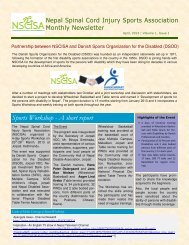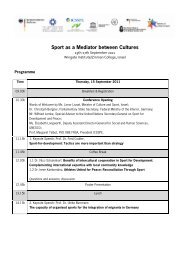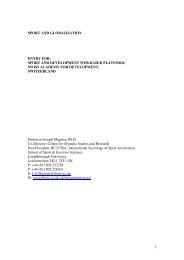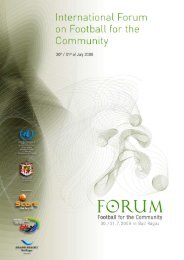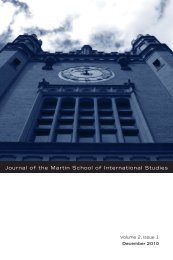The contribution of sport within the process - International Platform ...
The contribution of sport within the process - International Platform ...
The contribution of sport within the process - International Platform ...
Create successful ePaper yourself
Turn your PDF publications into a flip-book with our unique Google optimized e-Paper software.
participant concerning <strong>the</strong> benefits perceived by <strong>the</strong>m during and after activities.<br />
<strong>The</strong> most common <strong>sport</strong> is football followed by volleyball and running, and <strong>the</strong><br />
respondents, before coming to CFS were on average involved in <strong>sport</strong> activities few<br />
times a week in football, less <strong>of</strong>ten in volleyball and running, and some <strong>of</strong> <strong>the</strong>m were<br />
approaching for <strong>the</strong> first time <strong>sport</strong>. <strong>The</strong> main reason why <strong>the</strong>y were not doing <strong>sport</strong><br />
more <strong>of</strong>ten is domestic work for both, males and females, where domestic work<br />
represents harvesting for boys and housekeeping and looking after bro<strong>the</strong>rs and<br />
sisters for girls. Sport was also not perceived as important from parents that at <strong>the</strong><br />
beginning were a bit reluctant to send <strong>the</strong>ir children at <strong>the</strong> centre. After a while, as<br />
highlight in <strong>the</strong> FGD <strong>the</strong>y modified <strong>the</strong>ir thought seeing a positive changing <strong>of</strong><br />
behaviour in <strong>the</strong>ir children.<br />
As indicated in <strong>the</strong> Free time graph (where <strong>the</strong> percentage represent <strong>the</strong> result <strong>of</strong><br />
a multiple choice question) most <strong>of</strong> <strong>the</strong>m work in <strong>the</strong>ir compound and at <strong>the</strong> same time<br />
look for a job for income. For sure poverty remains <strong>the</strong> main problem and <strong>sport</strong> can<br />
only be a piece <strong>of</strong> <strong>the</strong> puzzle bringing benefits as sense <strong>of</strong> responsibility and respect,<br />
sense <strong>of</strong> commitment and achievement, sense <strong>of</strong> self confidence, all <strong>of</strong> <strong>the</strong>m<br />
necessary to build a better future.<br />
A great result is given by key questions like “I fell more positive about my future” and<br />
“I’m more integrated with o<strong>the</strong>r communities” where 100% answered in a positive way.<br />
Borsani Serena – Master in Human Rights and Conflict Management 2008<br />
Dissertation<br />
Figure 12 - Graph “What do you do in<br />
your free time”<br />
Youth are more confident about<br />
<strong>the</strong>mselves and more tolerant with<br />
o<strong>the</strong>rs, with signs <strong>of</strong> hope for future,<br />
where hope or <strong>the</strong> belief that hope is<br />
<strong>the</strong>re, is a chance for success in reconciliation. In this case <strong>sport</strong> has been contributing<br />
to speed up trauma healing, through building and enhancing that inner strength called<br />
resilience.<br />
Making new friend, staying with o<strong>the</strong>rs, having fun, improving skills, being member <strong>of</strong> a<br />
team are building confidence are among <strong>the</strong> main reasons why <strong>the</strong>y like <strong>sport</strong>.<br />
57<br />
Figure 13 - Graph "How do you feel since you started taking part in <strong>sport</strong> activities?"<br />
Figure 14 - Graph "I feel more positive about my future"<br />
Borsani Serena – Master in Human Rights and Conflict Management 2008<br />
Dissertation<br />
Sport activities were <strong>of</strong>ten followed by<br />
discussion groups or psychosocial individual<br />
or group sessions in which youth could freely<br />
talk about <strong>the</strong>ir feeling about past, present<br />
and future. <strong>The</strong> individual sessions have<br />
been targeting to youth not yet ready for an<br />
open discussion with o<strong>the</strong>r ethnicity, in order<br />
to reduce <strong>the</strong>ir anger and bitterness as well as to build <strong>the</strong> necessary empathy to<br />
have <strong>the</strong> willingness to listen to <strong>the</strong> o<strong>the</strong>rs.<br />
<strong>The</strong> group discussions which aim is to create <strong>the</strong> opportunity for an inter-ethnic<br />
dialogue have been ga<strong>the</strong>ring already mixed participants.<br />
Figure 15 - Graph "At times I think I'm not good at all"<br />
58



